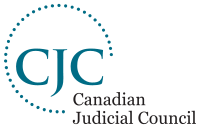
Canadian Judicial Council
Encyclopedia

The Council is chaired by the Chief Justice of Canada, currently the Right Honourable Beverley McLachlin. There are 38 other Council members, who are the chief justices and associate chief justices of Canada's superior courts, the senior judges of the territorial courts, and the Chief Justice of the Court Martial Appeal Court of Canada.
Review of Complaints against Federal judges in Canada
The Canadian Judicial Council was granted power under the Judges Act to investigate complaints made by members of the public or the Attorney General about the conduct (not the decisions) of federally appointed judges. After its review and investigation of a complaint, the Council can make recommendations, including to Parliament through the Minister of Justice that a judge be removed from office.By directing complaints to the Canadian Judicial Council, Canada's Parliament acknowledges that the public must have a way to voice its concerns about judges. At the same time, the system must allow judges to respond to allegations of misconduct in a fair way. The entire process must be efficient, fair, and objective. In all cases, judicial independence - the foundation of Canadian justice - is central to the process.
Canada is one of the very few countries where a complaint can be made against the Chief Justice in the same way as any other judge. The Chief Justice is not involved in the review of complaints.
History
The Council was created in 1971 following years of discussion about the need to coordinate professional development and judicial conduct matters for judges, in a way that would respect the judiciary as an independent branch of government. The review of complaints had previously usually been coordinated by the federal Department of Justice, with the occasional involvement of local Chief Justices.A key factor that facilitated the creation of the Council was the case of Justice Landreville. He was charged with a criminal offence. Those charges were dismissed, but allegations of impropriety continued to be made by some. This gave rise to quite a bit of public debate; some in the legal profession criticized the fact that the judge was still sitting. A Committee of the Law Society, despite not having jurisdiction over a federally appointed judge, produced a negative report without even notifying Landreville of its proceedings.
There being no defined process to formally inquire into the conduct of a judge, the government then constituted a one-man Royal Commission headed by former Supreme Court Justice Ivan Rand. In his report, Rand found some improprieties and was critical of Justice Landreville. However, some said Mr Rand was biased and famous constitutional lawyer J.J. Robinette who represented Justice Landreville before the Commission was seriously critical of the process.
After the Rand report became public, a joint Committee of Parliament eventually recommended the judge's removal and he resigned.
There were many who came to a view that the process which had been followed was flawed: the absence of a process defined in legislation to review the conduct of a judge left too much room for review by the law societies, government or Parliament, of even other bodies without necessarily involving the judiciary.
Professor William Kaplan, in his book Bad Judgment, wrote that "Without a doubt, the Landreville case figured prominently in the decision to establish the council." He quotes the Parliamentary Secretary to the Minister of Justice who spoke during second reading of the Bill that created the Council: "Because the independence of the judiciary is an integral part of the Canadian democratic process, it is important that the judiciary become, to some extent, a self-disciplinary body." (Kaplan, p. 194)
"There is no doubt that the awkwardness and uncertainty of the Landreville proceeding was a factor motivating Parliament to adopt this new procedure." (Martin Friedland, A Place Apart: Judicial Independence and Accountability in Canada, 1995, p. 88).
Public Inquiries
While the majority of complaints are dealt with quickly and with resolve, there are some instances where a judge's conduct is considered to be of sufficient concern that further inquiry is warranted.Since 1971, there have been a total of 8 inquiries into the conduct of a particular judge: Cosgrove (2009), Matlow (2008), Boilard (2003), Flynn (2003), Flahiff (1999), Bienvenue (1996), Gratton (1994) and Hart, Jones and MacDonald (1990).
Criticisms
One criticism levelled at the Council is that it is composed only of judges. Some say that the review of complaints, in particular, should not be the exclusive domain of judges but should include others. Critics point to other judicial councils, such as provincial bodies, some of which include the participation of lawyers and members of the public.At the national level, the composition of judicial disciplinary bodies varies extensively. In the U.S., only judges are involved in the review of complaints at the federal level; in the U.K., complaints are initially reviewed by advisory committees made up of members of the judiciary, the legal profession, the magistracy and the public. A fully independent ombudsman (http://www.judicialombudsman.gov.uk) can review decisions relating to complaints. However, any decision to discipline a judge, short of removal from office, rests with the judiciary.
Some have also asked that complaints against judges be made public. However, anyone who wishes to complain against a judge can do so publicly, and indeed many do. In such cases, the Council's practice has been to publicize the outcome of the complaint. This was the case, for example, in regard to a complaint made against the Chief Justice of Canada:
http://www.cjc-ccm.gc.ca/english/news_en.asp?selMenu=news_2008_0925_en.asp

